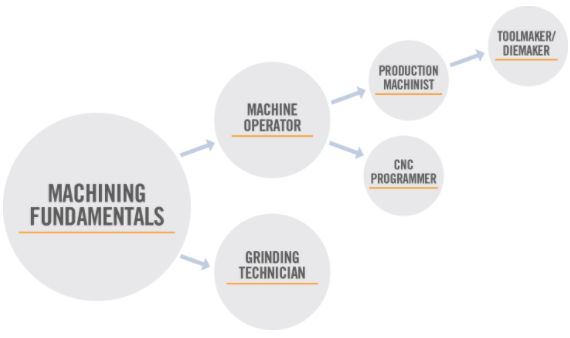TURNKEY TRAINING
for Machining
LEARNING PLANS FOR MANUFACTURING JOB ROLES
Turnkey Training from The Mackenzie Group offers a quick-start, progressive road map that allows manufacturers to build career paths for employees. Turnkey Training is intended to enhance your existing OJT and help you create a job progression plan. Unlike many other training programs, Turnkey Training requires minimal preparation. It is efficient, effective training that has been developed with input from manufacturing experts.
FLEXIBLE AND CONVENIENT
Online classes are self-paced, typically taking 60 minutes to complete. On average, employees can progress through a job role in one year with as little as 4 hours a month spent online
TURNKEY TRAINING OFFERS
- Predefined curriculum for each job role
- Engaging and interactive online classes
- Supplemental videos and a reinforcement task for each class
- Pre- or post-training knowledge assessments
- Access to our Learning Management System (LMS)
- Guidance from our Client Success team, including advice, insights, and ideas built on best practices and years of experience
CAREER PATHWAYS
FOR MACHINING JOB ROLES
Combine job roles for learning pathways, or offer single job roles for targeted learning. Large comprehensive programs also available.

MACHINING FUNDAMENTALS
Approximately 2 hours per month
Basic Measurement
Basics of Tolerance
Blueprint Reading
Calibration Fundamentals
Hole Standards and Inspection
Thread Standards and Inspection
5S Overview
Lean Manufacturing Overview
Essentials of Heat Treatment of Steel
Ferrous Metals
Introduction to Mechanical Properties
Band Saw Operation
Basic Cutting Theory
Cutting Processes
Introduction to Metal Cutting Fluids
Metal Cutting Fluid Safety
Overview of Machine Tools
ISO 9001:2015 ReviewBloodborne Pathogens
Fire Safety and Prevention
Hand and Power Tool Safety
Intro to OSHA
Lockout/Tagout Procedures
Noise Reduction and Hearing Conservation
Personal Protective Equipment
Powered Industrial Truck Safety
Safety for Lifting Devices
SDS and Hazard Communication
Walking and Working Surfaces
Geometry: Circles and Polygons
Geometry: Lines and Angles
Geometry: Triangles
Math Fundamentals
Math: Fractions and Decimals
Trigonometry: Sine, Cosine, Tangent
Units of Measurement
GRINDING TECHNICIAN
Approximately 3 hours per month
Basic Grinding Theory
Basics of the Centerless Grinder
Basics of the Cylindrical Grinder
Basics of the Surface Grinder
Centerless Grinder Operation
Cylindrical Grinder Operation
Dressing and Truing
Grinding Ferrous Metals
Grinding Nonferrous Metals
Grinding Processes
Grinding Safety
Grinding Variables
Grinding Wheel Geometry
Grinding Wheel Materials
Introduction to Grinding Fluids
Setup for the Centerless Grinder
Setup for the Cylindrical Grinder
Setup for the Surface GrinderSurface Grinder Operation
Basics of G Code Programming
Introduction to CNC Machines
Intro to Fastener Threads
Introduction to GD&T
Major Rules of GD&T
Surface Texture and Inspection
Metrics for Lean
Process Flow Charting
SPC Overview
Strategies for Setup Reduction
Troubleshooting
Essentials of Communication
Essentials of Leadership
Chucks, Collets, and Vises
Clamping Basics
Locating Devices
Supporting and Locating Principles
GRINDING TECHNICIAN
Approximately 2 hours per month
Basics of G Code Programming
Basics of the CNC Lathe
Basics of the CNC Mill
Control Panel Functions for the CNC Lathe
Control Panel Functions for the CNC Mill
Coordinates for the CNC Lathe
Coordinates for the CNC Mill
Introduction to CNC Machines
Offsets on the CNC Lathe
Offsets on the CNC Mill
Introduction to Fastener Threads
Surface Texture and Inspection
SPC Overview
Benchwork and Layout Operations
Engine Lathe Basics
Engine Lathe OperationEngine Lathe Setup
Holemaking on the Manual Mill
Manual Mill Basics
Manual Mill Operation
Manual Mill Setup
Classification of Steel
Intro to EDM
Safety for Metal Cutting
Machine Guarding
Chucks, Collets, and Vises
Clamping Basics
Locating Devices
Supporting and Locating Principles
CNC PROGRAMMER
Calculations for Programming the Lathe
Calculations for Programming the Mill
Canned Cycles for the Lathe
Canned Cycles for the Mill
Creating a CNC Milling Program
Creating a CNC Turning Program
Introduction to CAD and CAM for Machining
In-Line Inspection Applications
Introduction to GD&TMajor Rules of GD&T
Intro to Six Sigma
Metrics for Lean
Introduction to Metals
Speed and Feed for the Lathe
Speed and Feed for the Mill
Quality and Customer Service
Automated Systems and Control
Robot Axes
PRODUCTION MACHINIST
Calculations for Programming the Lathe
Calculations for Programming the Mill
Canned Cycles for the Lathe
Canned Cycles for the Mill
Creating a CNC Milling Program
Creating a CNC Turning Program
Introduction to GD&T
Major Rules of GD&T
Metrics for Lean
Process Flow Charting
Strategies for Setup Reduction
Troubleshooting
Taper Turning on the Engine Lathe
Threading on the Engine LatheANSI Insert Selection
Basic Cutting Theory
Carbide Grade Selection
Cutting Tool Materials
Drill Tool Geometry
Impact of Workpiece Materials
Lathe Tool Geometry
Mill Tool Geometry
Optimizing Tool Life and Process
Speed and Feed for the Lathe
Speed and Feed for the Mill
Essentials of Communication
Essentials of Leadership
TOOLMAKER AND DIEMAKER
Approximately 2 hours per month
Basic Grinding Theory
Basics of the Cylindrical Grinder
Basics of the Surface Grinder
Cylindrical Grinder Operation
Dressing and Truing
Grinding Ferrous Metals
Grinding Nonferrous Materials
Grinding Processes
Grinding Safety
Grinding VariablesGrinding Wheel Geometry
Grinding Wheel Materials
Introduction to Grinding Fluids
Setup for the Cylindrical Grinder
Setup for the Surface Grinder
Surface Grinder Operation
Die Cutting Variables
Material Tests for Welding
Fixture Design Basics

